Project Management Report: Risk, Contingency, and Strategies
VerifiedAdded on 2023/05/29
|7
|1200
|385
Report
AI Summary
This report delves into the intricacies of project management, examining critical aspects such as risk assessment, contingency planning, and strategic responses. The report begins by defining contingency and its role in mitigating project risks, exploring potential ethical concerns related to unspent contingency funds and their reporting. It then outlines a comprehensive training program designed for executives, covering essential knowledge areas like risk identification, qualitative and quantitative analysis, and response planning. Furthermore, the report contrasts risk management strategies across different industries, highlighting the distinct challenges and approaches for construction and IT projects. It provides a detailed analysis of industry-specific risks and suitable mitigation strategies, emphasizing the importance of tailored risk management frameworks. The report concludes with a list of references supporting the analysis.
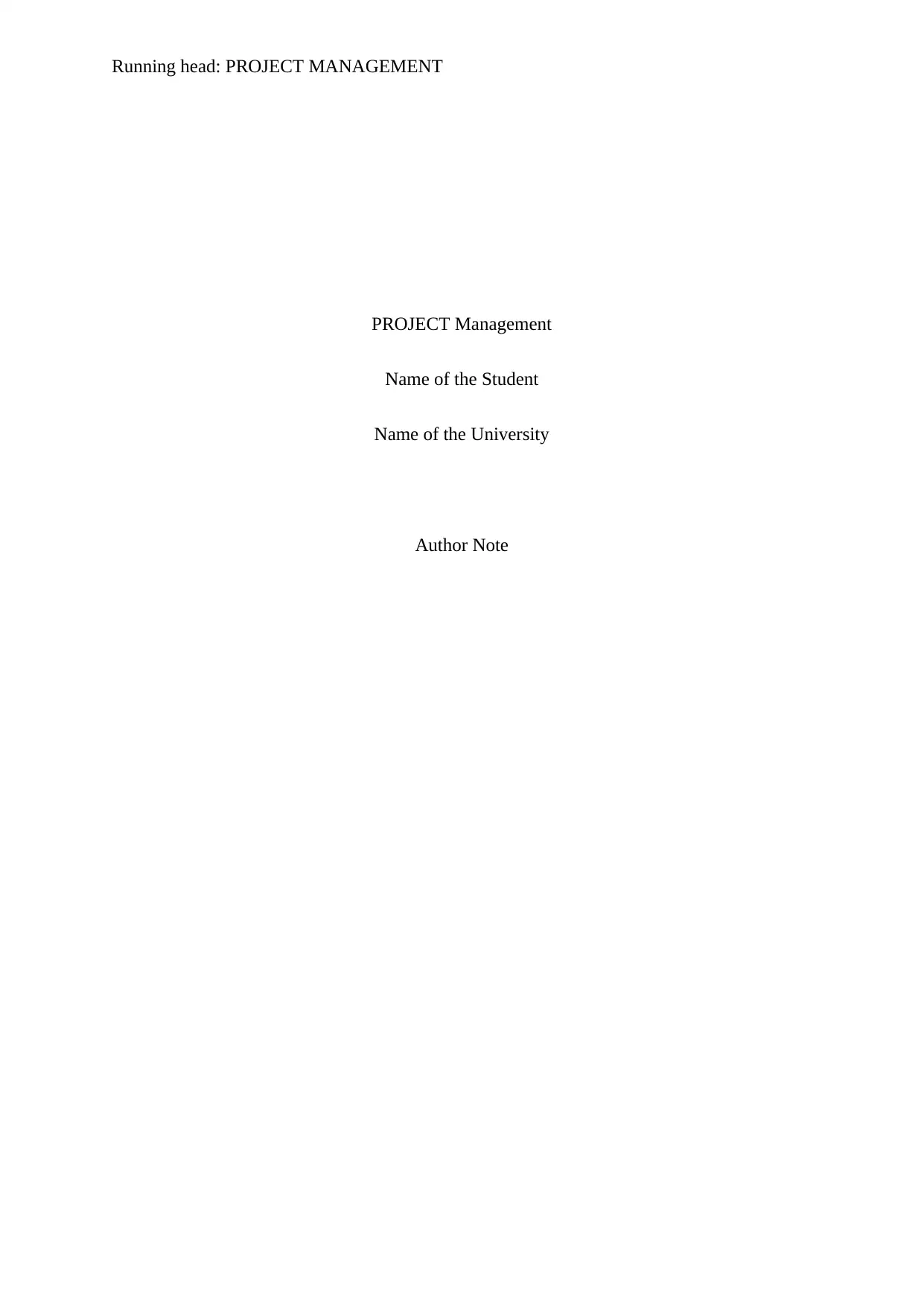
Running head: PROJECT MANAGEMENT
PROJECT Management
Name of the Student
Name of the University
Author Note
PROJECT Management
Name of the Student
Name of the University
Author Note
Paraphrase This Document
Need a fresh take? Get an instant paraphrase of this document with our AI Paraphraser
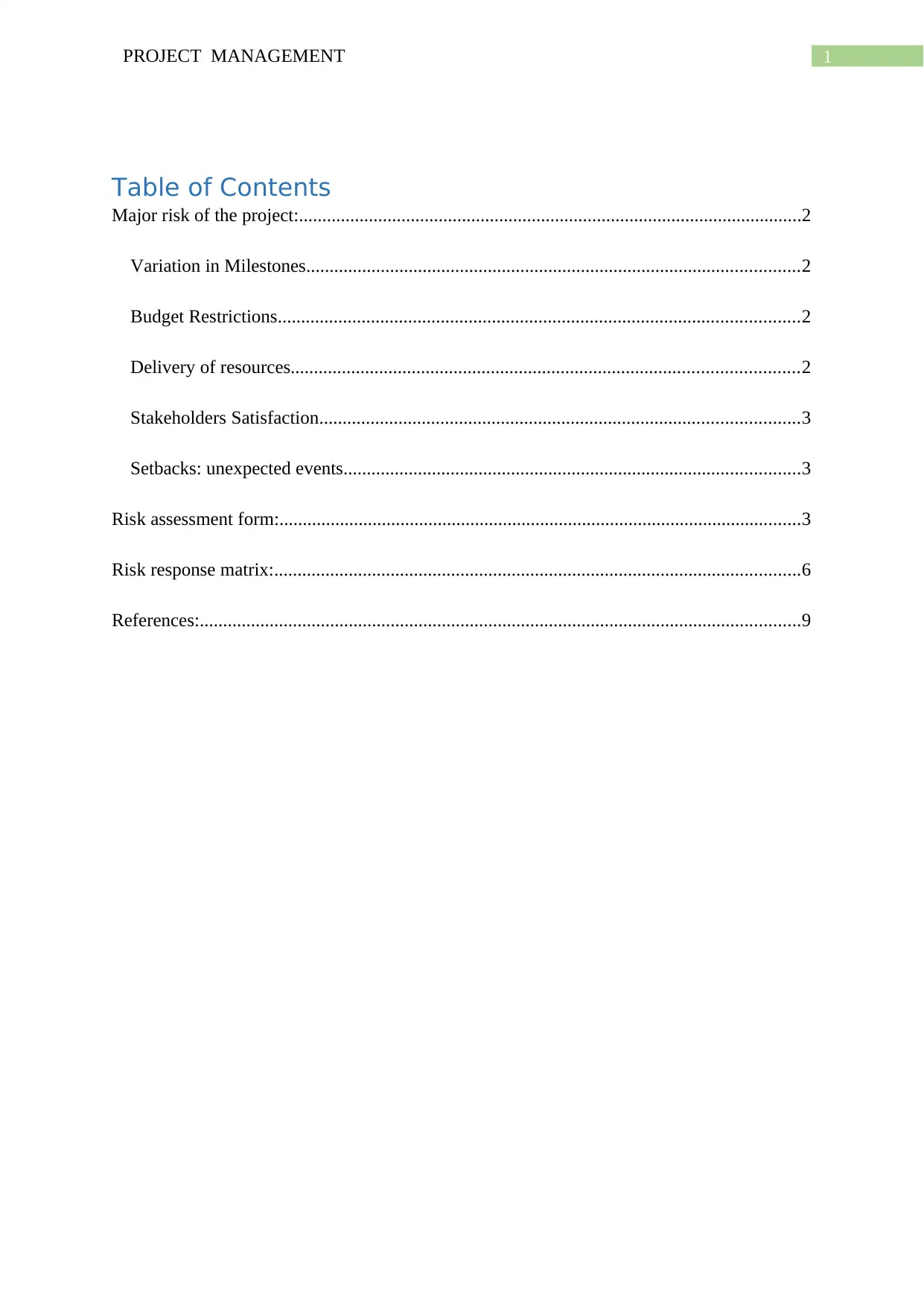
1PROJECT MANAGEMENT
Table of Contents
Major risk of the project:............................................................................................................2
Variation in Milestones..........................................................................................................2
Budget Restrictions................................................................................................................2
Delivery of resources.............................................................................................................2
Stakeholders Satisfaction.......................................................................................................3
Setbacks: unexpected events..................................................................................................3
Risk assessment form:................................................................................................................3
Risk response matrix:.................................................................................................................6
References:.................................................................................................................................9
Table of Contents
Major risk of the project:............................................................................................................2
Variation in Milestones..........................................................................................................2
Budget Restrictions................................................................................................................2
Delivery of resources.............................................................................................................2
Stakeholders Satisfaction.......................................................................................................3
Setbacks: unexpected events..................................................................................................3
Risk assessment form:................................................................................................................3
Risk response matrix:.................................................................................................................6
References:.................................................................................................................................9
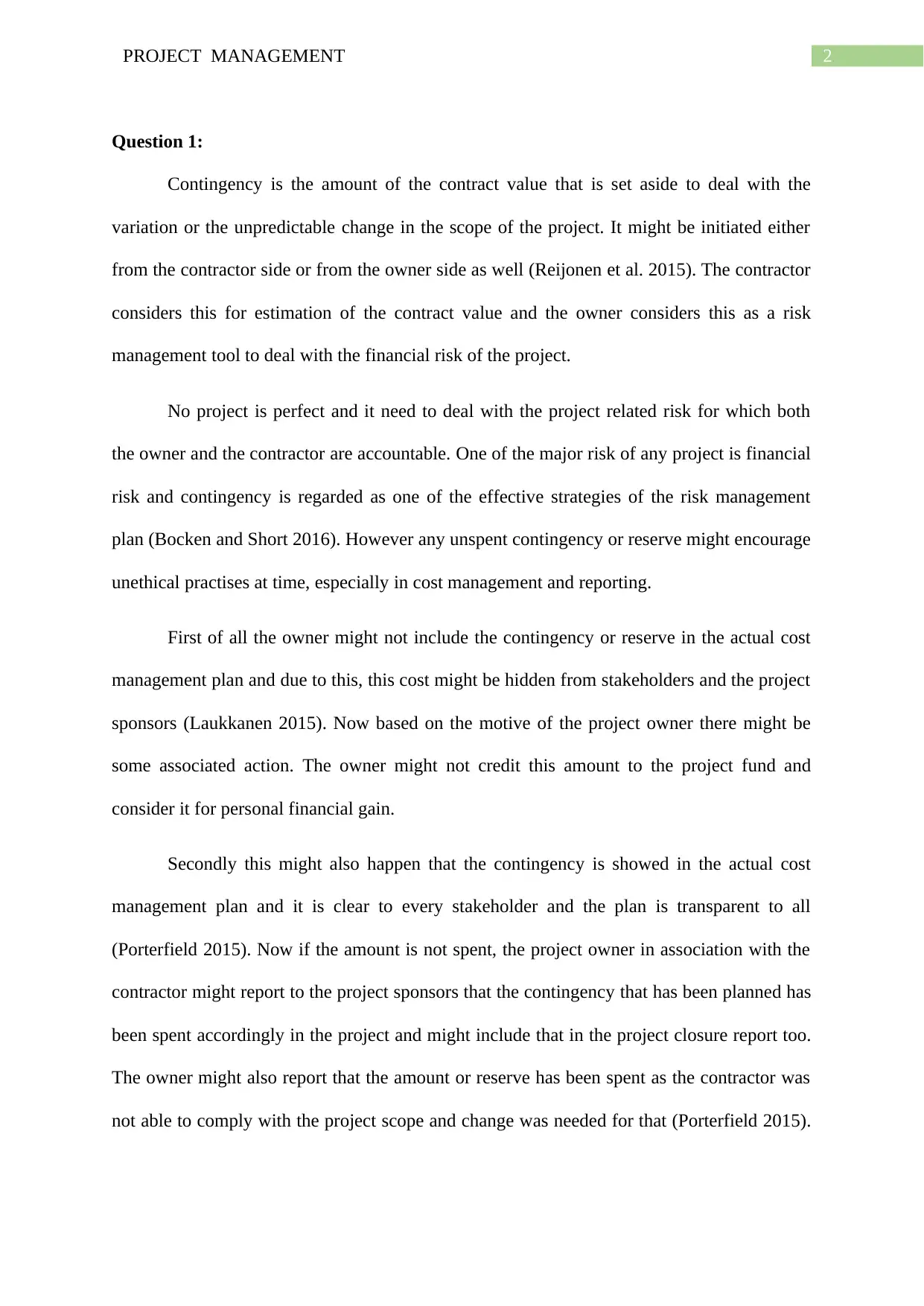
2PROJECT MANAGEMENT
Question 1:
Contingency is the amount of the contract value that is set aside to deal with the
variation or the unpredictable change in the scope of the project. It might be initiated either
from the contractor side or from the owner side as well (Reijonen et al. 2015). The contractor
considers this for estimation of the contract value and the owner considers this as a risk
management tool to deal with the financial risk of the project.
No project is perfect and it need to deal with the project related risk for which both
the owner and the contractor are accountable. One of the major risk of any project is financial
risk and contingency is regarded as one of the effective strategies of the risk management
plan (Bocken and Short 2016). However any unspent contingency or reserve might encourage
unethical practises at time, especially in cost management and reporting.
First of all the owner might not include the contingency or reserve in the actual cost
management plan and due to this, this cost might be hidden from stakeholders and the project
sponsors (Laukkanen 2015). Now based on the motive of the project owner there might be
some associated action. The owner might not credit this amount to the project fund and
consider it for personal financial gain.
Secondly this might also happen that the contingency is showed in the actual cost
management plan and it is clear to every stakeholder and the plan is transparent to all
(Porterfield 2015). Now if the amount is not spent, the project owner in association with the
contractor might report to the project sponsors that the contingency that has been planned has
been spent accordingly in the project and might include that in the project closure report too.
The owner might also report that the amount or reserve has been spent as the contractor was
not able to comply with the project scope and change was needed for that (Porterfield 2015).
Question 1:
Contingency is the amount of the contract value that is set aside to deal with the
variation or the unpredictable change in the scope of the project. It might be initiated either
from the contractor side or from the owner side as well (Reijonen et al. 2015). The contractor
considers this for estimation of the contract value and the owner considers this as a risk
management tool to deal with the financial risk of the project.
No project is perfect and it need to deal with the project related risk for which both
the owner and the contractor are accountable. One of the major risk of any project is financial
risk and contingency is regarded as one of the effective strategies of the risk management
plan (Bocken and Short 2016). However any unspent contingency or reserve might encourage
unethical practises at time, especially in cost management and reporting.
First of all the owner might not include the contingency or reserve in the actual cost
management plan and due to this, this cost might be hidden from stakeholders and the project
sponsors (Laukkanen 2015). Now based on the motive of the project owner there might be
some associated action. The owner might not credit this amount to the project fund and
consider it for personal financial gain.
Secondly this might also happen that the contingency is showed in the actual cost
management plan and it is clear to every stakeholder and the plan is transparent to all
(Porterfield 2015). Now if the amount is not spent, the project owner in association with the
contractor might report to the project sponsors that the contingency that has been planned has
been spent accordingly in the project and might include that in the project closure report too.
The owner might also report that the amount or reserve has been spent as the contractor was
not able to comply with the project scope and change was needed for that (Porterfield 2015).
⊘ This is a preview!⊘
Do you want full access?
Subscribe today to unlock all pages.

Trusted by 1+ million students worldwide
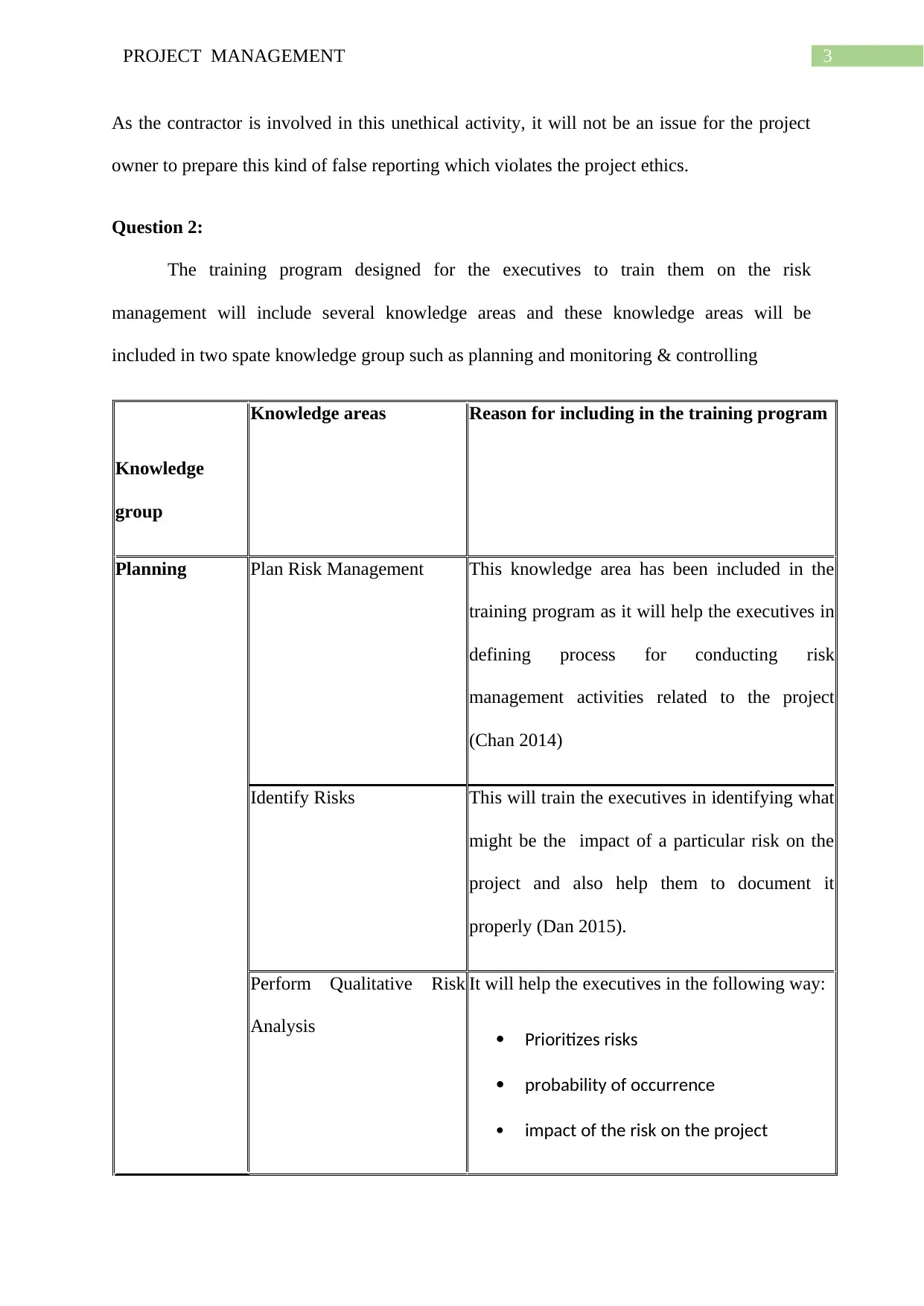
3PROJECT MANAGEMENT
As the contractor is involved in this unethical activity, it will not be an issue for the project
owner to prepare this kind of false reporting which violates the project ethics.
Question 2:
The training program designed for the executives to train them on the risk
management will include several knowledge areas and these knowledge areas will be
included in two spate knowledge group such as planning and monitoring & controlling
Knowledge
group
Knowledge areas Reason for including in the training program
Planning Plan Risk Management This knowledge area has been included in the
training program as it will help the executives in
defining process for conducting risk
management activities related to the project
(Chan 2014)
Identify Risks This will train the executives in identifying what
might be the impact of a particular risk on the
project and also help them to document it
properly (Dan 2015).
Perform Qualitative Risk
Analysis
It will help the executives in the following way:
Prioritizes risks
probability of occurrence
impact of the risk on the project
As the contractor is involved in this unethical activity, it will not be an issue for the project
owner to prepare this kind of false reporting which violates the project ethics.
Question 2:
The training program designed for the executives to train them on the risk
management will include several knowledge areas and these knowledge areas will be
included in two spate knowledge group such as planning and monitoring & controlling
Knowledge
group
Knowledge areas Reason for including in the training program
Planning Plan Risk Management This knowledge area has been included in the
training program as it will help the executives in
defining process for conducting risk
management activities related to the project
(Chan 2014)
Identify Risks This will train the executives in identifying what
might be the impact of a particular risk on the
project and also help them to document it
properly (Dan 2015).
Perform Qualitative Risk
Analysis
It will help the executives in the following way:
Prioritizes risks
probability of occurrence
impact of the risk on the project
Paraphrase This Document
Need a fresh take? Get an instant paraphrase of this document with our AI Paraphraser
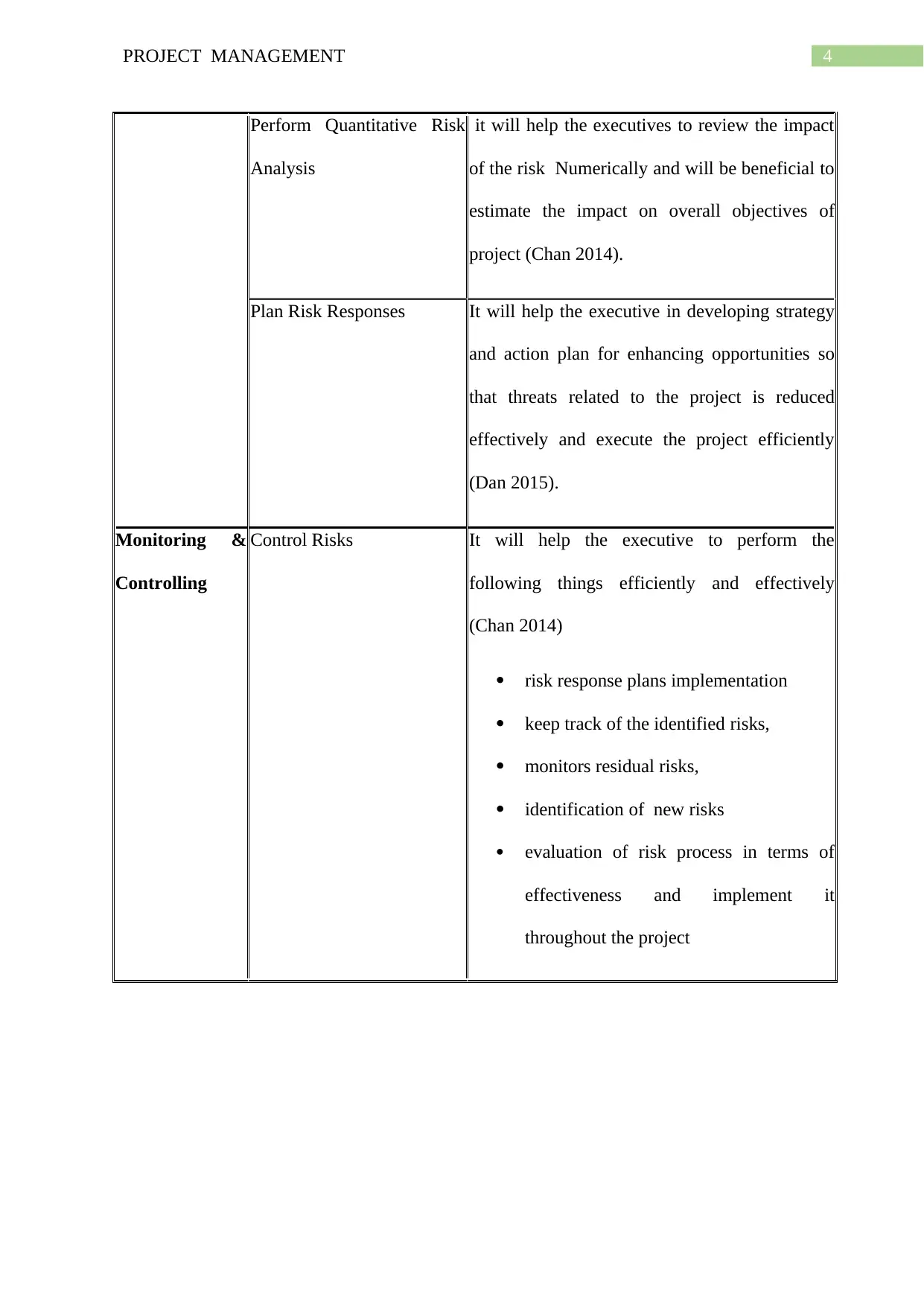
4PROJECT MANAGEMENT
Perform Quantitative Risk
Analysis
it will help the executives to review the impact
of the risk Numerically and will be beneficial to
estimate the impact on overall objectives of
project (Chan 2014).
Plan Risk Responses It will help the executive in developing strategy
and action plan for enhancing opportunities so
that threats related to the project is reduced
effectively and execute the project efficiently
(Dan 2015).
Monitoring &
Controlling
Control Risks It will help the executive to perform the
following things efficiently and effectively
(Chan 2014)
risk response plans implementation
keep track of the identified risks,
monitors residual risks,
identification of new risks
evaluation of risk process in terms of
effectiveness and implement it
throughout the project
Perform Quantitative Risk
Analysis
it will help the executives to review the impact
of the risk Numerically and will be beneficial to
estimate the impact on overall objectives of
project (Chan 2014).
Plan Risk Responses It will help the executive in developing strategy
and action plan for enhancing opportunities so
that threats related to the project is reduced
effectively and execute the project efficiently
(Dan 2015).
Monitoring &
Controlling
Control Risks It will help the executive to perform the
following things efficiently and effectively
(Chan 2014)
risk response plans implementation
keep track of the identified risks,
monitors residual risks,
identification of new risks
evaluation of risk process in terms of
effectiveness and implement it
throughout the project

5PROJECT MANAGEMENT
Question 3:
Strategies for Risk management differs according to the nature of the industry in
which the company operates. Strategies applied for one industry might not work for other
industry completely (Raisch 2016). It is because there is variation in project scope and project
activities. Now the scope of an IT project is not same as the scope of construction project.
The major risk for construction project are delay in project due to bad weather, Equipment
damage, Injuries to third parties and workers. Whether major risk of IT project are faulty
code for software, issue in code integration with the system integration , bug in software and
system crash due to software bug, security issues of the software (Chan 2014).
The possible strategies for construction related risks are backup plan for work shift
due to weather change, review of equipment, verification of site safety and review of contract
(Warren 2017). Whether for IT projects the strategies are review of software code, through
testing of system and code compatibility.
As the nature of activities and risks varies according to the nature of industry, it affect
the selection and employment of risk management strategies.
Question 3:
Strategies for Risk management differs according to the nature of the industry in
which the company operates. Strategies applied for one industry might not work for other
industry completely (Raisch 2016). It is because there is variation in project scope and project
activities. Now the scope of an IT project is not same as the scope of construction project.
The major risk for construction project are delay in project due to bad weather, Equipment
damage, Injuries to third parties and workers. Whether major risk of IT project are faulty
code for software, issue in code integration with the system integration , bug in software and
system crash due to software bug, security issues of the software (Chan 2014).
The possible strategies for construction related risks are backup plan for work shift
due to weather change, review of equipment, verification of site safety and review of contract
(Warren 2017). Whether for IT projects the strategies are review of software code, through
testing of system and code compatibility.
As the nature of activities and risks varies according to the nature of industry, it affect
the selection and employment of risk management strategies.
⊘ This is a preview!⊘
Do you want full access?
Subscribe today to unlock all pages.

Trusted by 1+ million students worldwide

6PROJECT MANAGEMENT
References:
Bocken, N.M.P. & Short, S.W. (2016). The theory of effective Risk management
frameworks: a comprehensive discussion. McGraw-Hill, Inc.
Chan, C. (2014, January). The importance of Risk management frameworks two execute
project
Dan, A., the scope and status of viewer in art. (2015). Method and apparatus for leading
effective project execution.
Laukkanen, T. (2015). The definition and scope of Risk management frameworks in project
management. A modern theory of art, 42, pp.35-46.
Porterfield, T.E. (2015). Evaluation of Risk management frameworks: an empirical
investigation of viewer scope and success. International Journal of project
management, 40(6), pp.435-455.
Raisch, W. (2016). Towards a sufficiency-driven art and culture: evaluation of as-Is
Workflow Modelling, 18, pp.41-61.
Reijonen, H., Hirvonen, S., Nagy, G., Laukkanen, T. and Gabrielsson, M. (2015). The bias of
project manager towards Risk management frameworks. A modern approach, 51,
pp.35-46.
Warren. N. (2017, January). The importance of post evaluation for successful project
implementation: an intuitive guide.
References:
Bocken, N.M.P. & Short, S.W. (2016). The theory of effective Risk management
frameworks: a comprehensive discussion. McGraw-Hill, Inc.
Chan, C. (2014, January). The importance of Risk management frameworks two execute
project
Dan, A., the scope and status of viewer in art. (2015). Method and apparatus for leading
effective project execution.
Laukkanen, T. (2015). The definition and scope of Risk management frameworks in project
management. A modern theory of art, 42, pp.35-46.
Porterfield, T.E. (2015). Evaluation of Risk management frameworks: an empirical
investigation of viewer scope and success. International Journal of project
management, 40(6), pp.435-455.
Raisch, W. (2016). Towards a sufficiency-driven art and culture: evaluation of as-Is
Workflow Modelling, 18, pp.41-61.
Reijonen, H., Hirvonen, S., Nagy, G., Laukkanen, T. and Gabrielsson, M. (2015). The bias of
project manager towards Risk management frameworks. A modern approach, 51,
pp.35-46.
Warren. N. (2017, January). The importance of post evaluation for successful project
implementation: an intuitive guide.
1 out of 7
Related Documents
Your All-in-One AI-Powered Toolkit for Academic Success.
+13062052269
info@desklib.com
Available 24*7 on WhatsApp / Email
![[object Object]](/_next/static/media/star-bottom.7253800d.svg)
Unlock your academic potential
Copyright © 2020–2025 A2Z Services. All Rights Reserved. Developed and managed by ZUCOL.





